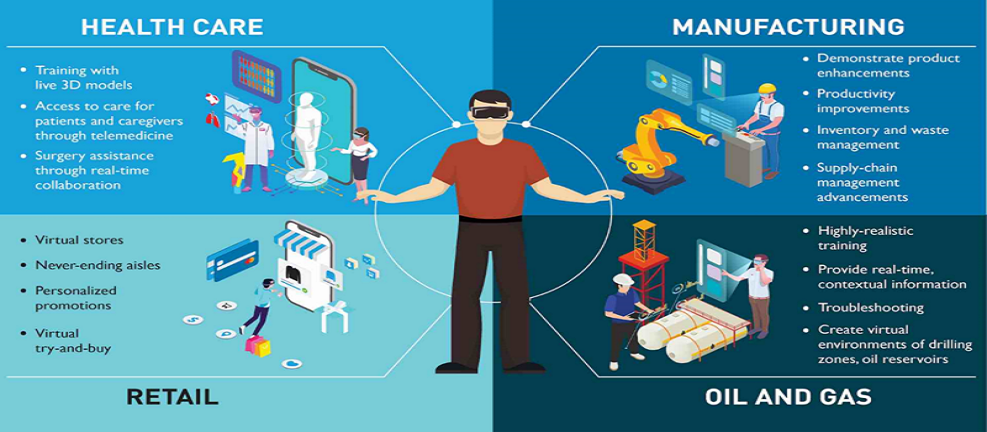Augmented Reality (AR) and Virtual Reality (VR) have already created their impact in entertainment and gaming segments and are now evolving as business game changers across industries globally. These technologies are transforming how businesses engage and interact with customers, providing off and on-the-job training to employees, and designing their products. Even without considering the metaverse ecosystem that is touted to be the next revolution in the technology horizon, these technologies will be disrupters, helping businesses enhance their top and bottom lines.
Statistics show that AR devices are forecasted to increase from 1.07 billion in 2022 to 1.4 billion in 2023 to 1.73 billion in 2024. It is evident from the numbers that these technologies are gaining significant adoption across multiple industries because of the numerous benefits they bring. A BCG and Mordor Intelligence survey estimates the current worldwide market value for AR/VR/MR to be around $30.7 billion and is estimated to grow to $300 billion by 2024.
The Current Market Scenario for AR/VR
Virtual reality was identified more with hardware hitherto, but it is gradually getting into the software arena and Augmented Reality is being adopted in various areas of business operations. While IDC has estimated worldwide spending on augmented reality and virtual reality (AR/VR) to grow to $50.9 billion in 2026 at a five-year compound annual growth rate (CAGR) of 32.3%, another study by the Markets and Markets projects the VR market to grow to 20.9 billion US dollars by 2025 at an expected CAGR of 27.9% between 2020 to 2025.
These studies and surveys also suggest that training and industrial maintenance are the commercial use cases that are expected to receive the largest investment in augmented and virtual reality. On the other hand, VR and AR gaming and VR video are forecasted to receive the biggest slice of investment in consumer use cases with an estimated spending of US$ 17.6 billion in 2024 in those segments. Multiple surveys and studies present differing estimates, but all point to accelerated growth in the AR/VR space.
The Trends of the Impacts of VR/AR in the Coming Years
The potential for Augmented Reality (AR) and Virtual Reality (VR) is vast and yet to be tapped fully and includes the ability to significantly enhance customer service, reduce onboarding time, and improve operational efficiency, resulting in reduced employee turnover and decreased incident costs. Let us touch base on the VR/AR trends likely to unfold in the upcoming years and how they will impact business and life.
Collaboration of AI with AR/VR
Along with virtual reality, and augmented reality, artificial intelligence has been making impacts on businesses individually. The VR/AR development companies and developers will explore the possibilities of the collaboration of these technologies, with the support of AI and ML methodologies and capabilities. This collaboration will help increase the creation of highly interactive workspaces and improve image recognition capabilities.
Increased Creation of Virtual Avatars
Many famous virtual avatars have emerged In the last few years, with the use of AR/VR technologies, which have become very popular to the extent of evolving as virtual influencers. Businesses have started using these avatars in their business and marketing processes for attracting customers and as well enabling them to navigate through online stores and the physical store. The potential market for AR avatars is expected to grow substantially.
Autonomous Vehicles Powered by AR
Artificial intelligence is the biggest technology working in autonomous vehicles, one of the hottest future trends people are looking forward to, but automobile manufacturers are exploring the benefits of integrating AR/VR technologies into autonomous vehicles in the immediate future. The automotive industry leaders have already started exploring the idea of using VR/AR technology trends to reimagine the way people use voice assistants, in-car AR, and more while driving or traveling in autonomous cars.
5G Accelerating AR/VR Revolution
5G will revolutionize everything that uses or is run on the internet, but it is VR/AR that is impacted more drastically than anything else. With the super-fast network that 5G offers, the data is transferred to the cloud storage, and processed to deliver an improved virtual experience to the customers who use VR/AR. Moreover, the 5G technology can enhance the experience even in low-bandwidth, low-latency environments, making the experience enjoyable even with low-cost AR/VR headsets and devices.
Emergence of WebAR
Advancing from the AR/VR experience that was limited to mobile devices till recently, the advent of WebAR will allow users to interact with augmented reality in the web space through web browsers like Google Chrome, and Mozilla Firefox, regardless of the device the AR/VR applications run upon, removing the barriers to its usage and enhancing the overall use experience.
Enhancing Remote Assistance
This is another area that is going to benefit largely from the trends in AR VR. These technologies will facilitate technicians to see on-site situations in real time through devices that have VR/AR on them. They help the technicians to collaborate with the remote teams to assess the situations at the site and help them with proper feedback/comments/notes/institutions to solve the problems.
Improving Healthcare Services
There is increased application of AR, VR, and MR in various healthcare applications such as training, vein visualization, physical therapy, breastfeeding assistance, facial recognition for patients, medical presentations, and use as medical devices. Virtual reality and Augmented reality have the potential capabilities to transform the way diseases can be diagnosed to provide proper treatment, making healthcare more efficient and accessible to everyone.
Empowering Education and Training Delivery
The immersive nature of virtual reality technology will allow teachers to engage students, particularly distance learners, to teach in a much better interactive and collaborative manner. Augmented reality, with the help of AR-powered wearable devices such as smart glasses, contacts, and headsets, will enhance the learning experience. This also helps reduce the cost of learning materials and makes education easily accessible to everyone.
AR/VR-Powered Shopping Experience
These technologies will dramatically transform the way customers shop online and offline. AR/VR allows customers to deal with products in innovative ways that provide personalized experiences to shoppers. Many apparel and fashion brands have apps that allow users to scan their bodies to receive accurate sizing suggestions. AR and VR enable retailers to run virtual stores for shoppers to select and try the products and retailers to ship those products without the need for physical stores.
Summing Up
The immersive nature of AR/VR capabilities will change the structure of consumer electronics in the future. The coming years will see AR technology being utilized to read messages and smart glasses being used to look through social media like Instagram. No business, small or big, cannot afford to be left behind in the VR/AR world unfolding in front of us. In such a scenario, you need to prepare for the near future to remain sustainable and profitable. If you don’t have an internal team with the required skillsets to adopt the VR/AR capabilities, you must explore the Open Talent or TaaS (Task as a Service) platforms to help keep you at the forefront of future AR/VR trends.




